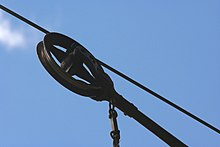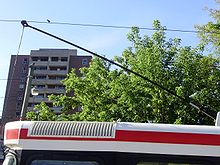Trolley pole

A trolley pole is a tapered cylindrical pole of wood or metal, used to transfer electricity from a "live" overhead wire to the control and the electric traction motors of a tram or trolley bus. The use of overhead wire in a system of current collection is reputed to be the 1880 invention of Frank J. Sprague,[1] while the first working trolley pole was developed and demonstrated by Charles Van Depoele, in autumn 1885.[2]
Origin of the term

The term trolley predates the invention of the trolley pole. The earliest electric cars did not use a pole, but rather a system in which each car dragged behind it an overhead cable connected to a small cart – or "troller" – that rode on a "track" of overhead wires. From the side, the dragging lines made the car seem to be "trolling", as in fishing. Later, when a pole was added, it came to be known as a trolley pole.
The term trolley, also used to describe the pole or the passenger car using the trolley pole, is derived from the grooved conductive wheel attached to the end of the pole that "trolls" the overhead wire.
An early development of an experimental tramway in Toronto, Ontario was built in 1883, having been developed by John Joseph Wright, brother of swindler Whitaker Wright. While Wright may have assisted in the installation of electric railways at the Canadian National Exhibition (CNE), and may even have used a pole system, there is no evidence. Likewise, Wright never filed or was issued a patent.[3]
Credit for development of the first working trolley pole is given to Charles Van Depoele, a Belgian-born engineer who moved to the United States in 1869. Van Depoele made the first public demonstration of the spring-loaded device on a temporary streetcar line installed at the Toronto Industrial Exhibition (now the CNE) in autumn 1885.[2] Depoele's first trolley pole was "crude" and not very reliable, and he reverted to using the troller system of current collection for a commercial installation on a streetcar system in South Bend, Indiana, which opened on November 14, 1885, and on one in Montgomery, Alabama, in April 1886. However, within a few months, Van Depoele switched to the trolley-pole system for the Montgomery operation.[2] Van Depoele and fellow inventor Frank J. Sprague were "working on similar ideas at about the same time",[4] and Sprague employed trolley-pole current collection on an electric streetcar system he installed in Richmond, Virginia, in 1888, also improving the trolley wheel and pole designs. Known as the Richmond Union Passenger Railway, this 12-mile system was the first large-scale trolley line in the world, opening to great fanfare on February 12, 1888.[5]
The grooved trolley wheel was used on many large city systems through the 1940s and 1950s; it was generally used on systems with "old" style round cross sectional overhead wire. The trolley wheel was problematic at best; the circumferential contact of the grooved wheel bearing on the underside of the overhead wire provided minimal electrical contact and tended to arc excessively, increasing overhead wire wear . The newer sliding carbon trolley shoe was generally used with a "newer" grooved overhead trolley wire of a figure "8" cross section. The sliding trolley shoe provided better electrical contact (with a reduction in arcing), and it dramatically reduced overhead wire wear. Many systems began converting to the sliding trolley shoe in the 1920s; Milwaukee, Wisconsin converted its large system in the late 1920s. Curiously, Philadelphia did not convert its trolley wheels on its remaining streetcars until 1978. Although a streetcar with a trolley wheel may evoke an antique look, the trolley shoe is modern and more practical as well as economical.
Description of the device

A trolley pole is not "attached" to the overhead wire. The pole sits atop a sprung base on the roof of the vehicle, with springs providing the pressure to keep the trolley wheel or shoe in contact with the wire. If the pole is made of wood, a cable brings the electrical current down to the vehicle. A metal pole may use such a cable, or may itself be electrically "live", requiring the base to be insulated from the vehicle body.
On systems with double-ended railway cars capable of running in both directions, the trolley pole must always be pulled behind the car and not pushed, or dewiring is very likely, which can cause damage to the overhead wires. At terminus points, the conductor must turn the trolley pole around to face the correct direction, pulling it off the wire either with a rope or a pole and walking it around to the other end. In some cases, two trolley poles are provided, one for each direction: in this case it is a matter of raising one and lowering the other. Since the operator could raise the pole at one end whilst the conductor lowered the other, this saved time and was much easier for the conductor. Care must be taken to raise the downed pole first, to eliminate the damage caused by arcing between the pole and wire. In the US, the dual-pole system was the most common arrangement on double-ended vehicles. However, pushing of the pole (called "back-poling" in the US or "spear-poling" in Australia), was quite common where the trams were moving at slow speeds, such as at wye terminals (also known as reversers) and whilst backing into the sheds.

Trolley poles are usually raised and lowered manually by a rope from the back of the vehicle. The rope feeds into a spring reel mechanism, called a trolley catcher or "trolley retriever". The trolley catcher contains a detent, like that in an automotive shoulder safety belt, which "catches" the rope to prevent the trolley pole from flying upward if the pole is dewired. The similar looking retriever (see photo) adds a spring mechanism that yanks the pole downward if it should leave the wire, pulling it away from all overhead wire fittings. Catchers are commonly used on trams operating at lower speeds, as in a city, whilst retrievers are used on suburban and interurban lines to limit damage to the overhead at speed.
On some older systems, the poles were raised and lowered using a long pole with a metal hook. Where available, these may have been made of bamboo due to its length, natural straightness and strength, combined with its relative light weight and the fact that it is an insulator. Trolleybuses usually carried one with the vehicle, for use in the event of dewirement, but tram systems usually had them placed along the route at locations where the trolley pole would need reversing.
The poles used on trolleybuses are typically longer than those used on trams, to allow the bus to take fuller advantage of its not being restricted to a fixed path in the street (the rails), by giving a degree of lateral steerability, enabling the trolleybus to board passengers at curbside.
Single- and double-pole usage
When used on a trolley car or tram, i.e., a railway vehicle, a single trolley pole usually collects current from the overhead wire, and the steel rails on the tracks act as the electrical return. Trolleybuses, on the other hand, must use two trolley poles and dual overhead wires, one pole and wire for the positive "live" current, the other for the negative or neutral return. The tramway system in Havana, Cuba, also utilised the dual wire system,[6] as did the Cincinnati (Ohio) streetcar system. To reduce electrolytic damage to underground pipes and metallic structures, most tram lines operated with the wire positive with respect to the rails.
Decline in usage on railways

All trolleybuses use trolley poles, and thus trolley poles remain in use worldwide, wherever trolleybuses are in operation (currently, some 315 cities),[7] and several manufacturers continue to make them, including Vossloh-Kiepe, Škoda and Lekov.
However, on most railway vehicles using overhead wire, the trolley pole has given way to the bow collector or, later, the pantograph, a folding metal device that presses a wide contact pan against the overhead wire. While more complex than the trolley pole, the pantograph has the advantage of being almost free from dewiring, being more stable at high speed, and being easier to raise and lower automatically. Also, on double-ended trams, they eliminate the need to manually turn the trolley pole when changing direction. The use of pantographs (or bow collectors) exclusively also eliminates the need for wire frogs (switches in the overhead wiring) to make sure the pole goes in the correct direction at junctions.
Apart from heritage streetcar lines, very few tram/streetcar systems worldwide continue to use trolley poles on vehicles used in normal service. Among the largest exceptions are the streetcar systems of Toronto, Ontario; Philadelphia (the "Subway-Surface" lines and route 15); Riga, Latvia; Kolkata (formerly Calcutta), India; and Alexandria, Egypt. Smaller systems still using trolley poles for regular service include Hong Kong Tramways, the Daugavpils, Latvia system, and Rio de Janeiro's Santa Teresa Tramway.
These systems and a few others worldwide retain use of trolley poles, even on new streetcars, in order to avoid the difficulty and expense of modifying long stretches of existing overhead wires to accept pantographs. Trams or light rail cars equipped with pantographs normally cannot operate on lines with overhead wiring designed for trolley-pole collection. It is possible to construct overhead wiring that is capable of accommodating both trolley poles and pantographs, but such designs are more expensive to maintain and are generally seen only in cities where modern streetcars or light rail cars share tracks with preserved historic cars.
See also
References
- ^ Dr. Romin Koebel (2005). "Boston Transit Milestones". MIT Open Courseware. Archived from the original on 2006-09-20. Retrieved August 1, 2012.
- ^ a b c Middleton, William D. (1967). The Time of the Trolley, pp. 63–65, 67. Milwaukee: Kalmbach Publishing. ISBN 0-89024-013-2.
- ^ "Patents of Invention and the Story of Canadian Innovation". Library and Archives Canada.
- ^ Middleton (1967), p. 67.
- ^ "Electric Trolley System". Massachusetts Institute of Technology.
- ^ Morrison, Allen (1996). Latin America by Streetcar: A Pictorial Survey of Urban Rail Transport South of the U.S.A., p. 55. New York: Bonde Press. ISBN 0-9622348-3-4.
- ^ Webb, Mary (ed.) (2011). Jane's Urban Transport Systems 2011-2012, p. "[23]" (in foreword). Coulsdon, Surrey (UK): Jane's Information Group. ISBN 978-0-7106-2954-8.
